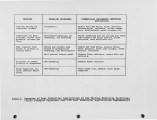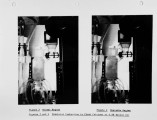| OCR Text |
Show 3. Burner flame outs on the run (with natural gas). 4. Unstable feed/combustion conditions causing cyclic operation rendering process control extremely difficult or impossible. These problems are normally resolved by on-site modifications following commissioning such as modifying the burners, moving their position, changing the posi tion of the feed inlet and modifying the air inlet. Clearly, the cost of such alterations are considerable and should, if possible, be avoided. The most effective way to minimize the risk of such problems is to model the system. 3.3.3 Modelling of Flash Calciners Clearly, flash calcination is a very difficult process to model effectively involving as it does, complex aerodynamics, fuel/air mixing and combustion reactions, feed size distribution and transport, heat transfer and the feed calcining reaction. At present, there is no one technique capable of modelling all these factors simultaneously, so partial modelling is adopted to build up an overall appreciation of the system. The following techniques were used:- 1. Water bead modelling was used to study the flow pattern, figure 21. 2. Acid alkali modelling was used to study the combustion, figure 22. 3. Computational fluid dynamic modelling was used to study the feed particle flow patterns and residence times, figure 23. 4. The well stirred furnace model was used to calculate the heat transfer. Using these techniques the geometry of the vessel and air inlet was assessed, the position and jet momentum of the burners optimized, and the position of the feed inlet fixed. The calciner was designed with a 4 second gas residence time and achieved 95 per cent calcination of the material at l525°-1545°F. Fuel/air mixing was so good that operation at 7% excess air was possible compared with a design target of 15%. The design production of 4520 ston/day has been exceeded and production of over 4950 ston/day achieved at a fuel consumption of 2.75 - 2.84 million Btu/ston (22). 4. CONCLUSIONS AND FUTURE PROSPECTS The examples given above are just a few of the two hundred or so real industrial problems which FCT has investigated using modelling techniques. In the great majority of applications, the modelling has revealed that substantial improvements can be achieved and these have been implemented successfully. When applying modelling techniques, it is essential that the limitations are fully understood and the model is effectively validated for the problem being studied. For example, the physical and mathematical model results presented above are unique to the burners and the plant in question. Each plant has its own individual characteristics and has to be examined in detail. Most failures of modelling can be traced to inadequate validation and poor operational data. |

































